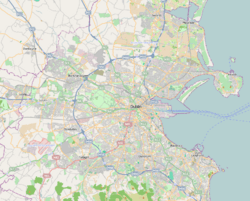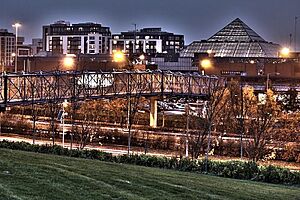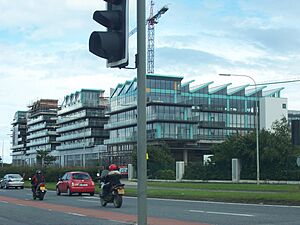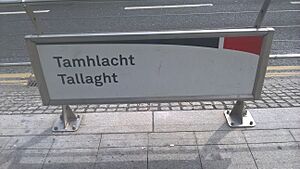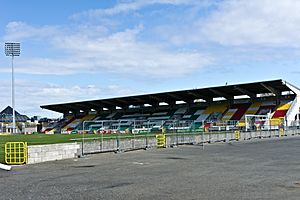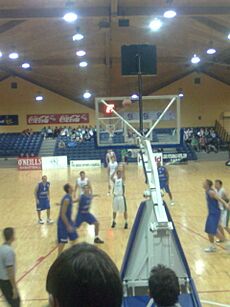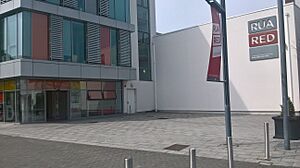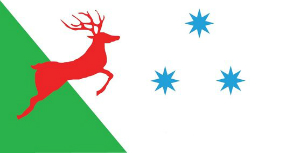Tallaght facts for kids
Quick facts for kids
Tallaght
Tamhlacht
|
|
|---|---|
|
Suburban town
|
|

From top, left to right: Skyline from Sean Walsh Park, High Street, Luas terminus; The Square Tallaght
|
|
| Motto(s):
Aontacht
(Irish: Unity) |
|
| Country | Ireland |
| Province | Leinster |
| County | South Dublin |
| Traditional county | County Dublin |
| Elevation | 90 m (300 ft) |
| Population
(2022 census)
|
|
| • Total | 81,022 |
| Time zone | UTC±0 (WET) |
| • Summer (DST) | UTC+1 (IST) |
| Eircode routing key |
D24
|
| Telephone area code | +353 (0)1 |
| Irish Grid Reference | O093265 |
Tallaght is a large town in South Dublin, Ireland. It is the biggest town in South Dublin and a major satellite town of Dublin. Long ago, in the 8th century, a monastery was built here. It became a very important religious center in medieval Ireland.
Before the 1960s, Tallaght was a small village. Its population was only about 2,500 people. Big housing developments started in the 1970s. A "town center" area has been growing since the late 1980s. Today, Tallaght is home to over 81,000 people. This makes it one of the largest settlements in Ireland without official city status.
The old village part of Tallaght is close to the River Dodder. Other parts of Tallaght are near the borders of Dublin City, County Kildare, and County Wicklow. Several small rivers and streams flow through the area.
Tallaght is also the name of a much larger historical area. This area includes other parts of southern Dublin.
Contents
What's in a Name? The Story of Tallaght
The name Tallaght comes from the Irish words támh-leacht. This means "plague pit" or "burial mound." It combines "támh" (plague) and "leacht" (grave or memorial stone).
The oldest stories about Tallaght are in an ancient book called Lebor Gabála Érenn. This book says that Parthalón, an early leader in Ireland, and many of his people died from a plague here. However, archaeologists have only found normal ancient graves in the area. These graves are mostly from the Bronze Age. They don't show any signs of a mass burial.
An old record, the Annals of the Four Masters, tells the legend: "Nine thousand of Parthalón's people died in one week. This is why it's called Taimhleacht Muintire Parthalóin."
The Irish name Tamhlacht is found in other places too. But the old stories suggest Tallaght is the place linked to this tale.
Tallaght also appears in the legends of the Fianna. These were a group of brave warriors. In one story, Fionn mac Cumhaill and his warriors go hunting in Gleann na Smól, near Tallaght. There, Fionn's son Oisín meets Niamh of the Golden Hair. She takes him to the magical land of Tír na nÓg on her fairy horse.
A Look Back: Tallaght's History
Early Days: Monks and Vikings
In 769 AD, St. Maelruain founded a monastery in Tallaght. This is when we start to have more reliable records of the area. The monastery was a famous center for learning and religious life. It was so important that it and another monastery were called the "two eyes of Ireland."
A famous monk named Aengus lived here. He and St. Maelruain might have written important religious texts together. St. Maelruain died in 792 AD and was buried in Tallaght.
In 811 AD, Vikings attacked the monastery. But it was rebuilt, and records continued for centuries. After the Norman invasion of Ireland in 1179, Tallaght became property of the Archbishop of Dublin. Sadly, all traces of the old monastery disappeared over time. This was due to wars, castles being built and torn down, and constant fighting.
Castles, Mills, and Changes
For much of the 1200s, Tallaght was peaceful. But then, local families like the O'Byrnes and O'Tooles started attacking. This caused people to leave their farms. In 1310, the town was allowed to build walls for protection. No signs of these walls remain today.
To stop the attacks, Tallaght Castle was built in 1324. It became an important defense point. Later, in the 1600s and 1700s, many mills were built along the Dodder River. This brought new wealth and led to many new houses being built.
In 1729, Archbishop Hoadley tore down the old castle. He built a grand palace for himself. But by 1821, this palace was also in ruins. It was sold to Major Palmer, who built his own mansion, Tallaght House, using materials from the palace.
The Dominicans, a group of monks, came to Tallaght in 1855. They set up a priory, which was also a training center for new Dominicans. They built new buildings over the years. Today, the priory grounds still have old features like the Archbishop's bathhouse.
The Battle of Tallaght and the Tramway
In 1867, a small battle happened in Tallaght during the Fenian Rising. A group of Irish rebels, called Fenians, gathered on Tallaght Hill. Police in Tallaght were warned and took up positions. They fired on the Fenians, who then retreated.
In 1888, the Dublin and Blessington Steam Tramway opened. It passed through Tallaght Village. This tram made it easier to transport goods and brought visitors from Dublin city.
Modern Tallaght: A Growing Town
In the 1960s, Tallaght was planned as a "new town" for Greater Dublin. However, it wasn't given enough facilities at first. This led to some problems in the 1970s and 1980s.
But Tallaght has grown a lot and now has its own strong identity. It has a lively arts, culture, sports, and business scene.
Tallaght's Civic Square is home to the local government offices, County Hall. It also has a modern library, a theater, and an arts center called "Rua Red." This center offers activities in music, dance, art, and drama. Tallaght is also home to the Tallaght Swim Team, Tallaght Rugby Club, the National Basketball Arena, and Shamrock Rovers F.C..
Where is Tallaght?
Location and Rivers
Tallaght is about 13 kilometers southwest of Dublin city. It is near the foothills of the Wicklow Mountains. There isn't an exact border for Tallaght. But it generally stretches from Templeogue in the northeast to Saggart in the west. It also goes towards the mountain areas and Firhouse.
The old village part of Tallaght is north of the River Dodder. Several streams flow through the area. These include the Jobstown Stream and the Fettercairn Stream. The Tymon River, which is part of the River Poddle, also starts nearby.
Getting Around: Transport in Tallaght
Tallaght is connected to Dublin city by buses and the Red Line of the Luas light rail system. The Luas opened in 2004. Many Luas stops are in the Tallaght area.
While it's easy to get to the city center, Tallaght isn't as well connected to other towns and suburbs. This means many people use cars. However, some bus routes do link Tallaght to places like Clondalkin, Dundrum, and Dún Laoghaire.
A plan for a metro rail line, called Metro West, was proposed to go through Tallaght. This line would connect Tallaght to other towns west of Dublin. It would also link to Dublin Airport.
An extension of the Luas Red Line was built from Belgard to Saggart and Citywest. This extension opened in 2011. It serves many housing areas in the region.
How Many People Live in Tallaght?
As of the 2022 census, the population of the main electoral divisions of Tallaght is 81,022. This number has grown from 76,119 in six years.
The South Dublin County Council estimated the population of Tallaght and its surrounding areas to be almost 73,000 in 2003. Tallaght is the main town for South Dublin County Council. Because there's no official boundary for Tallaght, it's hard to get an exact population number. But if you include all the nearby areas, Tallaght's population is larger than Galway City.
| Tallaght Ethnic groups 2011 | White Irish | Irish Traveller | Other White | Black | Asian | Other | Not Stated |
|---|---|---|---|---|---|---|---|
| Tallaght Population 69,454 | 58,596 | 787 | 3,934 | 2,001 | 1,271 | 856 | 2,009 |
The historical area of the civil parish of Tallaght includes even more places. Its population is over 101,000.
Different Parts of Tallaght
"Greater Tallaght" includes the original Tallaght village and other areas that used to be small settlements. These include Jobstown, Old Bawn, and Kilnamanagh.
The original Tallaght village is west of the main road. It has many shops, restaurants, and banks. The Technological University Dublin (Tallaght Campus), Saint Mary's Priory, and Saint Maelruain's Church are in this historic part.
The newer "town center" is south of the village. It has the main shopping center, The Square, the Luas stop, Tallaght University Hospital, County Hall, and the Civic Theatre.
Other areas like Tymon North, Old Bawn, Aylesbury, and Killinarden are mostly residential. They have many housing estates. These areas also have sports facilities like the National Basketball Arena. Tymon Park is a large park with sports grounds and playgrounds.
What to See and Do in Tallaght
Important Buildings and Places
Some historical places in Tallaght include St. Maelruain's Church and Tallaght Castle.
The modern "town center" has offices for local government and other services. It also has the County Library, Rua Red Arts Centre, and the Civic Theatre. Tallaght University Hospital is also located here.
Tallaght is home to The Square, one of Ireland's biggest shopping centers. It has many shops and a 13-screen cinema called Movies@ The Square.
There are five hotels in the town center area. South of the main road is Tallaght Stadium, a 6,000-seat football ground. Sean Walsh Memorial Park is also in this area.
Learning in Tallaght
Tallaght has many schools for different age groups. These include St. Mark's National School, Scoil Maelruain, and Old Bawn Community School. There are also Irish-speaking schools (Gaelscoileanna) like Scoil Santain.
Technological University Dublin (Tallaght Campus) is a college here. It offers many different degrees and courses. The Priory Institute at St. Mary's Priory also offers courses in Theology and Philosophy.
Sports in Tallaght
Football Fun
Shamrock Rovers F.C. is a professional football club based in Tallaght. They play their home games at Tallaght Stadium. They have won the Irish league title many times. In 2011, they made history by becoming the first Irish team to play in the group stages of the UEFA Europa League.
Other local football clubs include St Maelruans FC and Newtown Rangers AFC. Brookfield Celtic is a large youth football club in Tallaght.
Gaelic Games
Local Gaelic Athletic Association clubs include Saint Anne's GAA, Saint Marks GAA, and Thomas Davis GAA Club.
Other Sports and Activities
The National Basketball Arena is located east of the village.
The Dublin Mountains Way, a long walking path, starts at Sean Walsh Park. This path goes across the Dublin side of the Wicklow Mountains.
Tallaght also has a Swim Team, a Hockey Club, and several Taekwondo clubs. Tallaght Rugby Football Club was started in 2002.
Arts and Entertainment
Tallaght has two theaters: Tallaght Theatre and the Civic Theatre.
Rua Red Arts Centre hosts many art and entertainment events. Tallaght Young Filmmakers is a group for young people interested in making films.
Movies@ The Square is a cinema located in The Square shopping center. It has 11 screens and a VIP lounge.
Irish Language in Tallaght
Tallaght has a strong community of Irish speakers. This is supported by Gaelphobal Thamhlachta, a group that promotes Irish culture.
There are three Irish-speaking primary schools (Gaelscoileanna) in Tallaght. There is also an Irish-medium secondary school, Coláiste de hÍde.
In recent years, money has been given to help create an Irish-language cultural center in Tallaght village. This center includes a bilingual café called 'Aon Scéal?'.
The Tallaght Unity Flag
The Tallaght Unity Flag was designed by Seos Ó Colla. It was launched in 2017 by the Tallaght Historical Society and the Tallaght Community Council. It is now an unofficial flag for the whole Tallaght area.
The flag was first flown publicly at the Priory in Tallaght village during Tallafest 2017. It is meant to be a symbol of Tallaght's identity and community spirit.
What the Flag Means
The Tallaght Unity Flag has a red deer. This deer shows strength and moving forward. The green triangle represents the beautiful nature of Tallaght and Ireland. Three blue, eight-pointed stars are on the right side. These stars are inspired by a design from the Battle of Tallaght in 1867. They stand for endurance and unity. The white background means peace and working together.
Famous People from Tallaght
Many notable people come from Tallaght, including:
- Rhasidat Adeleke, an Irish Athlete
- Richard Baneham, who won two Oscars for Visual Effects
- Robbie Keane, a famous football player
- Katie McCabe, a well-known football player
- Lynn Ruane, a Senator and activist
- Aidan Turner, an actor
See also
 In Spanish: Tallaght para niños
In Spanish: Tallaght para niños


